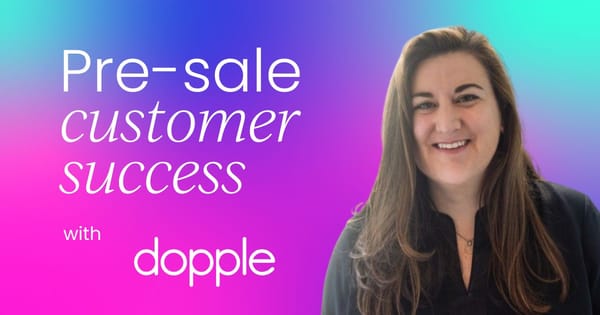Stop the post-sale customer success scramble
A deal closes, champagne pops, and then a brand-new team shows up to onboard the customer, piecing together half-remembered promises. Details slip, expectations blur, and trust starts leaking before the product even goes live.
That chaos exists because customer success joins too late.
Bringing CS into the sales process – even in small, strategic ways – can eliminate those frustrating handoffs, surface risk earlier, and keep customers aligned from day one.
It’s not about slowing down deals. It’s about making them stick.
From trust to handoff (and back again)
Think about a recent client who was… well, difficult, to put it mildly. Maybe expectations weren’t clear, maybe the renewal was painful, or perhaps they tried to walk away from the contract altogether.
Now ask yourself: why were they challenging?
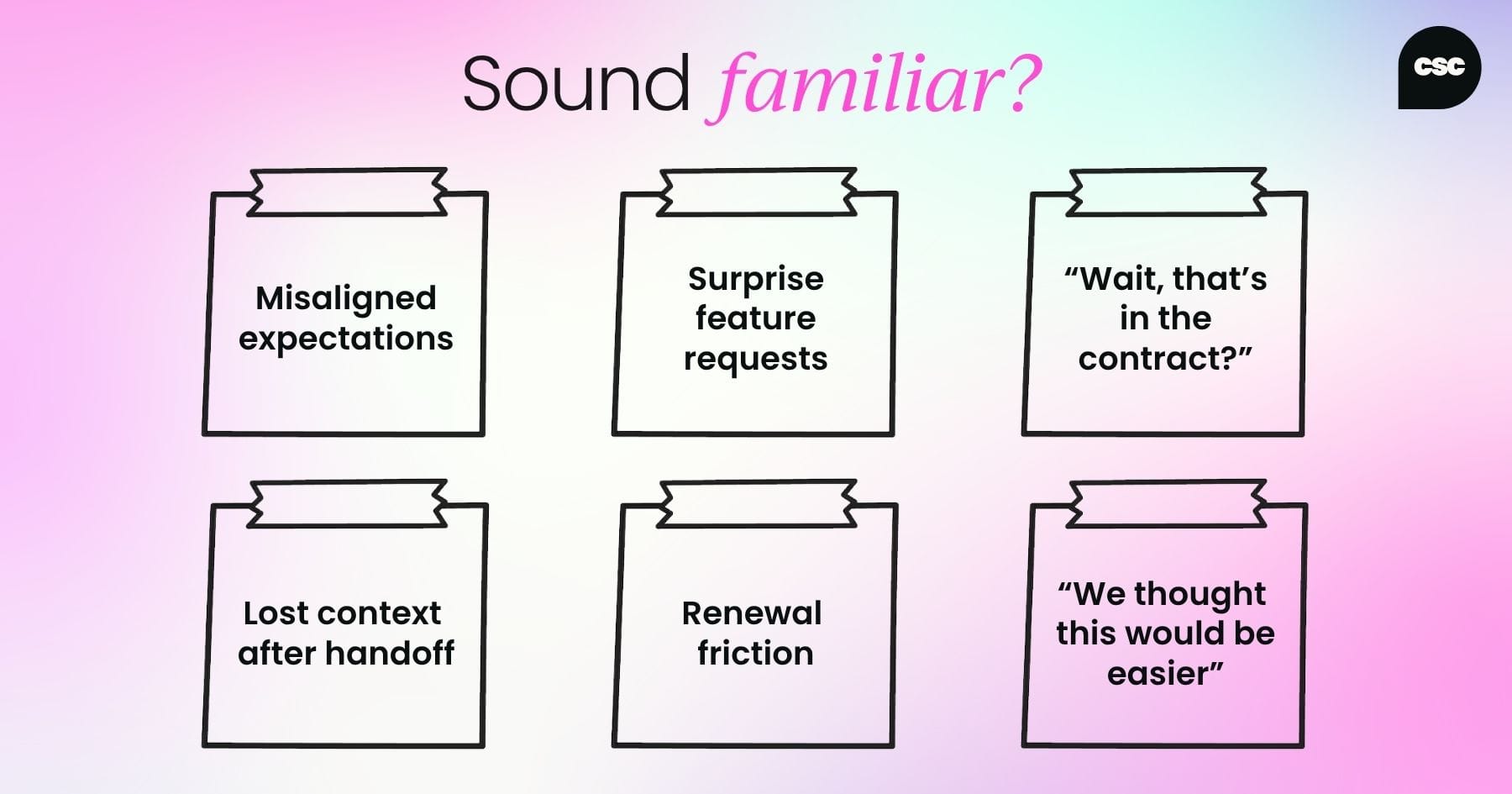
Take a moment to pinpoint the top three issues. Chances are, they’ll tie back to questions like:
- Do you clearly understand what value means to them?
- Are they actually seeing that value?
- Does the product meet their needs, or are they waiting on a future feature?
- Do you know their business goals?
- Do you know why they bought your product?
- Were any specific time commitments made or assumed?
- What was their time to value, shorter, longer, or exactly as expected?
- Do they understand what CS is actually there to do?
- How well do they fit into your ideal customer profile (ICP)?
- And finally, what were the surprises?
Now, keep those challenges in mind. Because while CS can’t appease every tough client, being involved earlier in the journey often makes these issues less painful — and so much more predictable.
The problem with a siloed customer journey
Here’s how it usually goes:
- Initial sale: Handled by marketing, SDRs, BDRs, and account executives.
- Onboarding: Once the deal is closed, the whole team passes the client off to a brand-new one: maybe project managers, sometimes CS (but not always).
- Adoption: After go-live, there’s another handoff — now to the customer success and support teams.
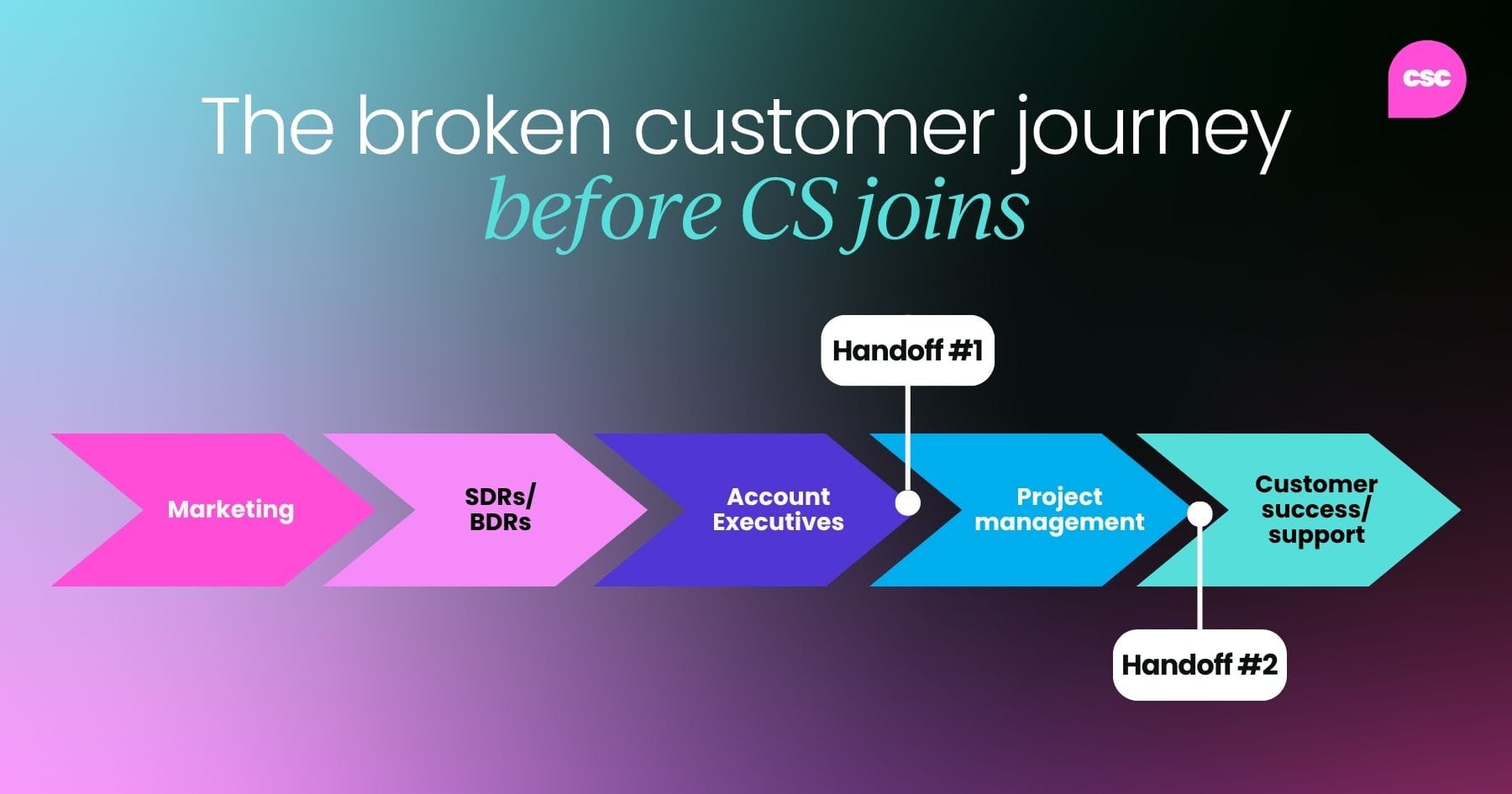
At every stage, the customer builds trust, only to feel like they’re starting over. Again and again. And with every transition, context gets lost. Promises blur. Relationships reset.
It’s a choppy, disjointed experience… and it’s entirely avoidable.
Building a connected journey
Now, picture a different model. One where CS is involved earlier – not from day one, not in every single meeting, but just enough to create continuity.
Your sales team still leads the deal. Marketing, SDRs, and Account Managers are all in play. But CS joins during key moments, laying the groundwork for value realization, setting expectations, and building rapport before the contract is even signed.
What changes?
- There’s no full handoff because CS was there before onboarding even began.
- Fewer things get lost in translation.
- Customers don’t have to re-explain their goals and frustrations over and over.
- Trust gets built and maintained.
Other teams can plug in throughout the journey, too. Marketing, for example, can support onboarding with training videos or milestone-based emails. Support joins later, but the client already knows their CS partner, and the baton pass is simple and smooth.
Even salespeople should stay lightly involved post-sale, checking in and maintaining relationships they worked hard to build. It’s not about monopolizing every stage; it’s about owning the relationship together.
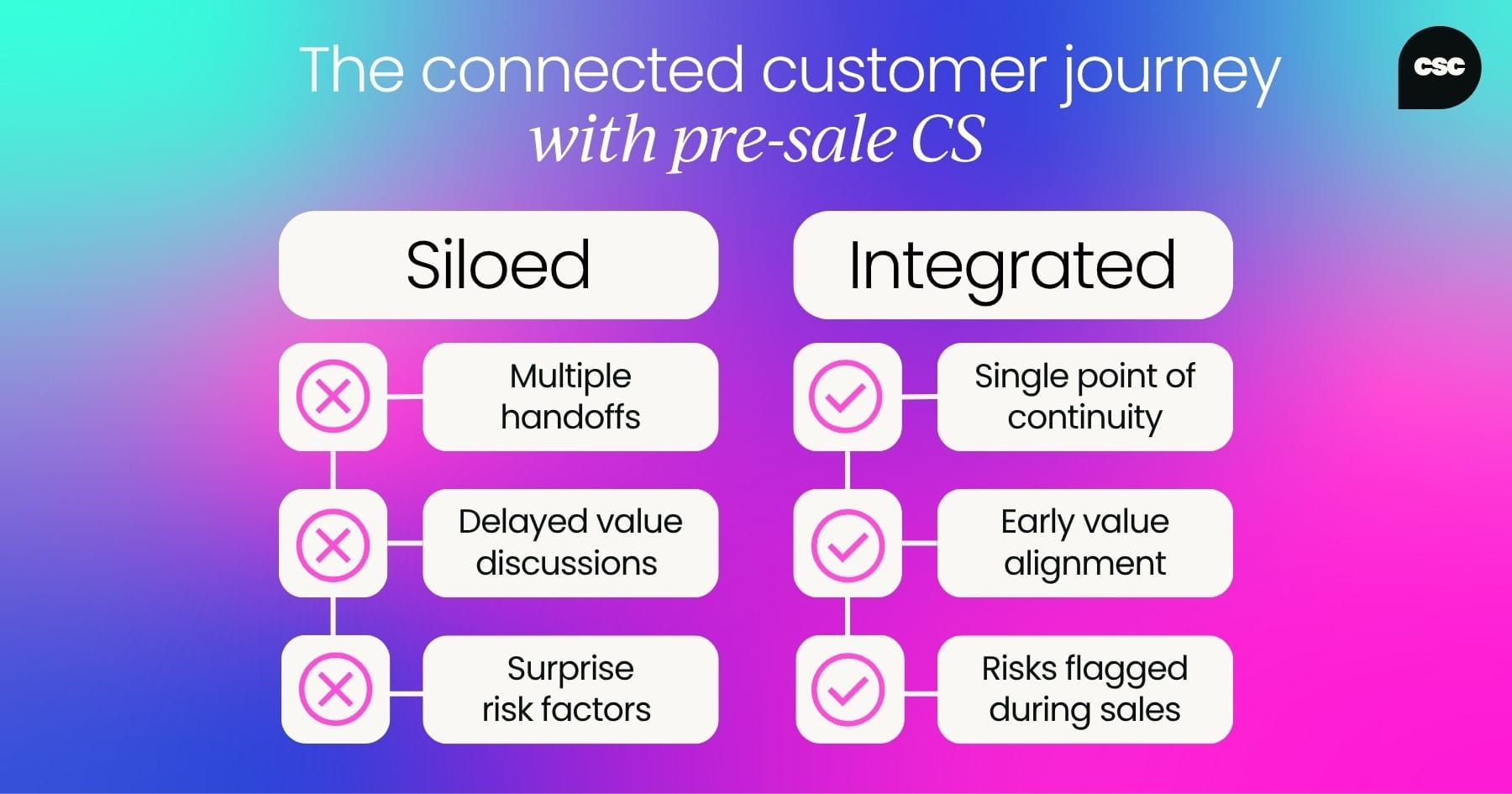
One team, one customer experience
Here’s a great quote from Coach K: “Two are better than one if two act as one.”
This applies perfectly to the CS-sales relationship. Acting as a single, unified team not only strengthens the deal, but it also protects the customer experience after the contract is signed.
Sales might worry that CS will say the wrong thing or complicate the close. But with the right plan, the opposite happens: CS can help close the gap between promises and delivery.
By working together earlier, you reduce confusion, avoid surprises, and set both your team and your customer up for long-term success.
Why bring customer success into the sales process?
You might be thinking, “Why would we bring CS into the sales process?” You definitely don’t want to slow things down or complicate the deal, right? And I get that – it can feel like adding another voice might just make things messier. But I’d argue it does the opposite.
The problem with waiting too long
Let’s go back to that siloed customer journey. In that model, your value realization program – that’s the work of aligning on success, defining value, setting baselines, and planning how you'll measure outcomes – doesn’t even begin until onboarding. CS hasn’t been involved in the sale, so they’re getting this information secondhand.
You're already chasing time to value, and you might still not have a clear picture of what value means to the customer.
So, now you're halfway through onboarding, trying to build a project plan or a success plan, and it’s all reactive.
Starting with value from day one
But if CS is involved during the sales process, you can start talking about value before the contract is even signed. You can build a success plan early, so by the time onboarding kicks off, you’re not scrambling, you’re aligned and ready to go.
And that’s just the beginning.

The benefits of bringing customer success into sales
1. Earlier value realization
You get a head start on building the value realization program; no waiting, no guesswork, and no piecing things together later.
2. Better ICP assessment
CS can help spot whether a prospect falls outside your ICP. Let’s be honest, sometimes you stretch your ICP to hit targets. That’s fine. But it’s better to recognize and plan for that during the sales process, not find out later when the relationship’s already strained.
3. Faster trust-building
When customers see that the person helping them after the sale is involved before the sale, it builds trust. They're more confident in what’s being promised because they know this isn’t just a “sales pitch.” It’s a partnership.
4. Fewer surprises
No more, “Well, the salesperson said we’d get this…” but there’s no record of it. CS is already in the room. If something’s promised, they hear it firsthand. And if something gets missed? There’s a better chance it gets caught early.
5. Quicker deal closure
One of our clients told us that they were already planning to sign, but having someone from CS join a meeting and walk them through what working with us would actually look like sealed the deal. It made everything real and reassured them they could trust us long-term.
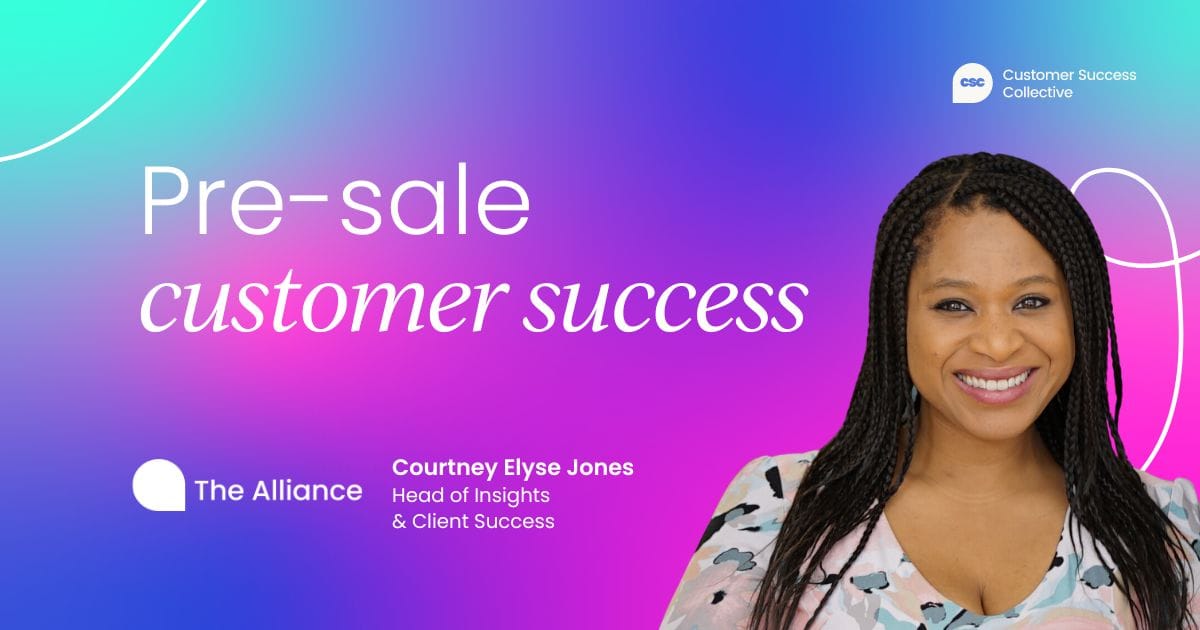
How to bring CS into sales (without slowing things down)
All of this sounds great, but let’s be real: how do you actually make it work without stepping on sales’ toes or dragging out the deal process?
Think back to that challenging client you identified earlier. If you had been part of their sales process, where could you have stepped in to set better expectations? Where could you have prevented misalignment?
6 easy ways to bring CS into the sales cycle
Product demos
Instead of just having sales engineers or Account Managers run the product demo, bring in CS to show how real clients use the product. This makes it easier to connect features with real-life challenges.
Contract reviews
Yes, CS can be helpful here too, especially when reviewing statements of work (SOWs) or project plans. It’s not about reviewing legal language; it’s about answering, “What does this mean in practice?” CS can give a future-focused view of what working together will look like.
Process and workflow discussions
If your product requires onboarding or workflow setup, CS can walk through what that process looks like. It helps set expectations around time and effort — even if the product is easy to use, there’s still some lift required.
Scope conversations
Scope creep is real. And if you’re in a creative or technical space, things like “why this product and not that one?” can get lost in translation. CS can offer context and guidance so the hand-off to delivery teams is smooth and well-understood.
Reference management
CS owns the post-sale relationship, so they know which clients make great references. They can also talk directly to prospects to understand what kind of reference they’re actually looking for, and help make the right connection.
Value discussions
This one’s huge. Why is the client buying? What results do they expect? CS can start that conversation early, not just inherit it later. It also ensures that post-sale work is tied directly to what the customer actually wants to achieve.

Multithreading the sales process
At the end of the day, bringing CS into the sales cycle gives you a new, credible voice in the room – one that will be there post-sale and can help reinforce the trust you're trying to build. It’s a simple way to “multithread” your approach and create more meaningful, transparent conversations.
You’re not adding more hoops to jump through. You’re building a smoother, more connected customer experience – and everyone benefits from that.
Making the case real: Revisiting your challenging client
Let’s go back to that exercise from earlier. Think about those challenges you listed; how many of them could’ve been avoided, or at least made easier, if you’d been involved earlier in the sales process?
Maybe during the product demo, you could’ve clarified that a certain feature doesn’t exist yet, or explained a workaround that’s available until Q4. Maybe a scope discussion could’ve uncovered that the client was only narrowing scope due to budget limitations, not because it was the best solution. These are all things that become easier to navigate when CS is involved early on.
Take a minute to reflect on the challenges from your client example. Could any of them have been addressed up front?

Aligning value from the start
Let’s look at some of those common client questions and how they tie back to your involvement in sales.
What does value mean to them?
This one’s huge. A simple value discussion early on can solve so much. Ask about their business goals and objectives, and make sure they actually connect to what you define as value.
For example, in our world working with furniture retailers, “value” might mean increasing conversion rates or raising average order value. But for brands, it might look completely different. There’s never a one-size-fits-all.
Are they seeing that value?
If you didn’t understand what value meant to them in the first place, how are you measuring it later? When you’re involved in the presales conversation, you can collect a baseline, so when results start to roll in, you’ve got something to compare them to.
And that makes renewal conversations a whole lot easier.
Product fit and expectation-setting
Does the product meet their needs?
If you gave the demo, you’d know where the sticky spots were – where they asked tough questions or seemed unsure. You’d hear firsthand if they expected a feature in a specific timeframe.
You’d also likely be more honest in these discussions, not because sales isn’t trustworthy, but because you’re the one who has to deliver on the expectations later.
What are their business goals?
In my previous role at Cylindo, we actually used a dedicated “goals” slide during the sales process that follows the client into onboarding. It outlines why they bought and what they want to achieve. CS can lead that discussion early, then keep leading it post-sale, creating a consistent, connected experience.
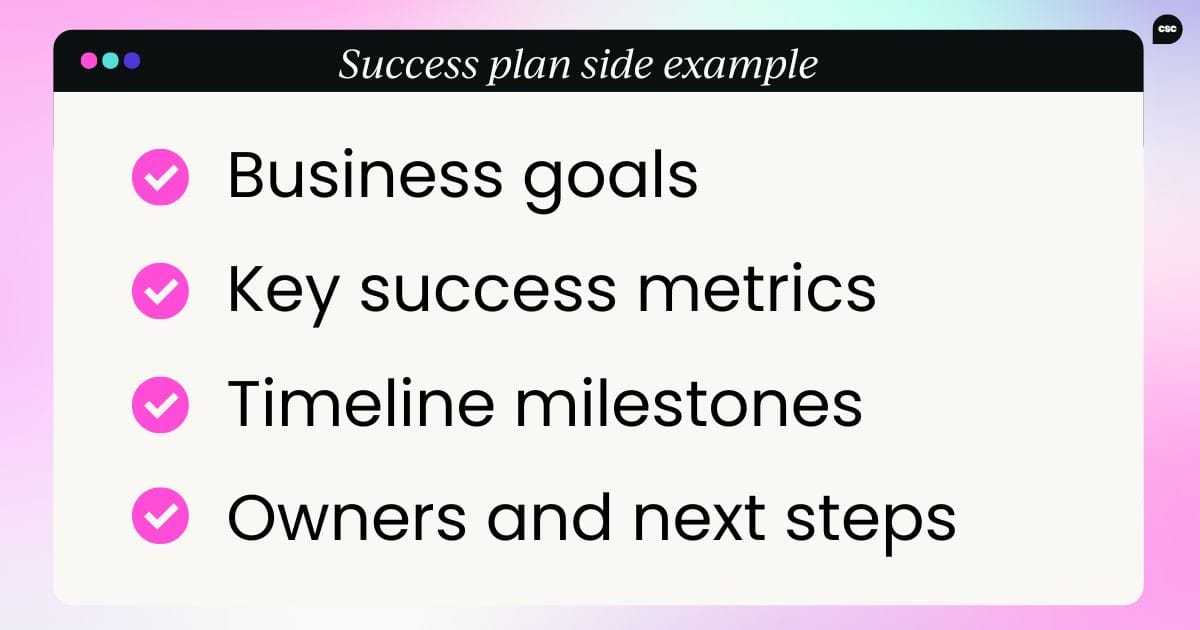
Are time commitments and expectations aligned?
Clients often think a new tool will be “plug and play” – five minutes of setup and they’re good to go. But as much as we’d love this to be our reality, we all know that’s rarely the case. If you’re involved early, you can set realistic expectations around time to value and project timelines — whether that’s in a demo, a contract/SOW review, or a value planning session.
Setting up for success post-sale
Do they understand your role?
Being present during the sale helps establish CS’s role from the beginning. They know who you are, what you do, and how you differ from sales or project management. That clarity pays off later.
Do they fit your ICP?
Early involvement lets you assess whether a prospect fits your ideal customer profile, and if they don’t, that’s still okay! The point isn’t to disqualify, it’s to flag and plan. You can set the right expectations, allocate resources appropriately, and reduce risk.
Fewer surprises, better outcomes
When CS joins the sales process, the outcome isn’t just smoother handovers – it’s fewer surprises for everyone.

This article is based on a workshop Johanna gave called "Pre-sale partnerships" at Customer Labs on January 29, 2025.
Upcoming workshops
Ready to level up your customer success skills? Our workshops run twice a quarter on Wednesdays, bringing you expert-led, hands-on learning experiences designed to solve real CS challenges.
- Strategic CS leadership with Andreja Mrzel (September 17)
- Elevate your CSM career with Elizabeth Blass (October 22)
- Build high-performing customer success teams with Dominique Duquennoy (November 19)
Each workshop offers exclusive frameworks, actionable strategies, and collaborative learning opportunities to help you drive retention, enhance satisfaction, and align customer success with your business goals.
Don't get FOMO
Register now to join industry leaders from companies like Microsoft, Entrust, and Blackline in these transformative sessions. Take what you learn back to your team and create bespoke programs that drive measurable success together.



 Follow us on LinkedIn
Follow us on LinkedIn


